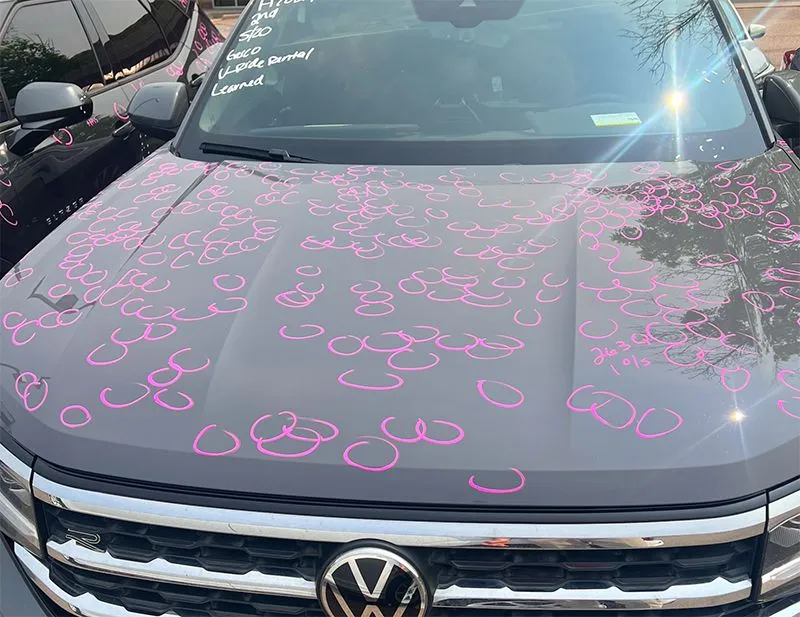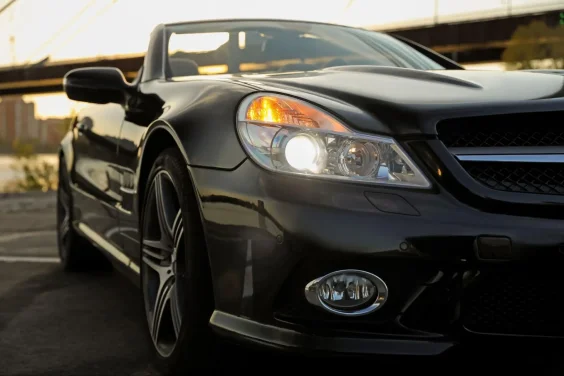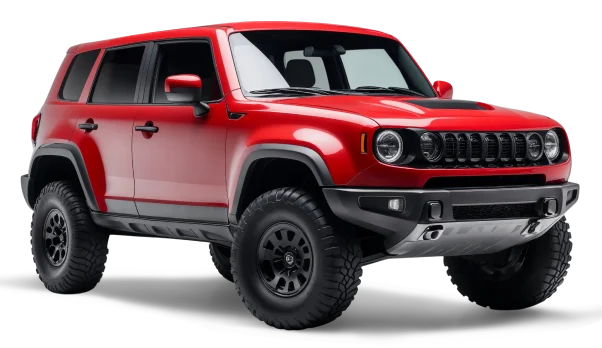Reading Time: 10 minutes
Paintless dent repair (PDR) is one of the most effective and efficient ways to fix minor dents and dings. It’s not a new process, but it’s often overlooked because people assume that all body damage requires sanding, filling, and repainting. That’s not always the case. And PDR can be more affordable and take less time. We’ve compiled a guide to paintless dent repair including:
- What it is and what it can fix
- How technicians perform PDR;
- When you need more extensive body work;
- And the cost differential between different types of repairs
What is Paintless Dent Repair (PDR)?
Paintless Dent Repair (PDR) is exactly what it sounds like: repairing dents without using paint or filler. Instead of covering up the damage, experienced technicians work the metal itself back into shape.
The process relies on carefully applied pressure from behind the panel. The technician works to get access to the back side of the dent where he or she can use a series of rods, picks, and hammers to massage the metal back into place. For areas that are tough to reach, there is a glue-pulling technique: applying a plastic tab to the dent with hot glue and then pulling the metal back into shape from the outside.
PDR works because of the way automotive paint is applied at the factory. Modern automotive paint systems include a flexible clear coat that allows for some movement without cracking. As long as the paint isn’t broken and the metal isn’t overstretched, technicians can usually work the dent out without damaging the finish. a
Types of Damage PDR Can Fix
- Door Dings – The most common type of dent. As long as the dent is shallow and the paint is intact, PDR is almost always the solution.
- Hail Damage – PDR is the gold standard for fixing hail damage. I’ve repaired cars with dozens of dents without needing to repaint a single panel.
- Light Creases – Creases are trickier because the metal has been stretched, but with the right tools and pressure points, they’re often fixable.
- Shopping Cart and Parking Lot Dents – If the impact didn’t crack the paint, PDR can usually handle it.
When Auto Body Shops Expand Beyond PDR
PDR isn’t a solution for every type of damage. If the dent is too deep, the metal might be overstretched, which means it won’t pop back into shape cleanly. Likewise, if the paint is cracked, the dent can be removed, but the panel will need to be refinished afterward. Getting PDR at a full-service shop can be an advantage: if PDR isn’t enough, it’s possible to switch to traditional repair methods without sending you somewhere else.
PDR is a specialized skill, though. Technicians spend years learning to develop the feel for how metal moves under pressure and how much force they can apply without damaging the paint. That’s why it’s important to have a trained technician handling the repair. When it’s done right, PDR leaves the panel looking like nothing ever happened, no filler, no repainting, no evidence of the original dent.
The Paintless Dent Repair Process
The goal of all PDR repairs is to carefully restore the metal to its original shape without disturbing the factory paint. Here’s how it looks step-by-step:
| Assessment |
| A technician inspects the area to understand a dent’s size, depth, and location. Not all dents are equal. Some are sharp, some are shallow, and the position of the dent can make a big difference in how to approach the repair. They also check the condition of the paint to make sure there’s no cracking or chipping, since PDR works best when the paint is intact. |
| Tools Used: LED dent light to create shadows and reflections to reveal exact shape and depth of dents, paint depth gauge to measure thickness of coat to ensure it’s safe to work on. |
| Accessing the Dent |
|---|
| Next, the technician needs to get behind the panel where the dent is located. That might mean removing interior trim, tail lights, or even inner door panels to reach the back side of the damage. For dents in tricky spots, like near edges or body lines, he or she may have to use specialized tools to work around reinforcements or structural components. |
| Tools Used: trim removal tools for removing door panels, window wedges to create space between tools and windows during the repair, wire hooks that can help improve leverage. |
| Precision Repair |
|---|
| Using a combination of hand-eye coordination and precise pressure, a technician will gently push and massage the dent out from behind the panel. He or she applies controlled pressure in small increments to avoid overstretching the metal. Sometimes they use a technique called “blending” where I tap down high spots around the dent to smooth out the repair. |
| Tools Used: PDR rods with various tips for massaging metal, rubber-tipped hammers for tapping down higher spots surrounding the dent, glue pulling kit for working on dents where access to the back of the panel is too difficult. |
| Final Inspection |
|---|
| Once the dent is out, the technician uses the same LED dent light again to check for any remaining imperfections. If necessary, they may go back in with a smaller rod or tap down any uneven spots. The goal is a smooth, undetectable repair that blends perfectly with the surrounding panel. |
| Tools Used: LED dent light for final inspection, polishing compound for any small surface marks |
Benefits of Paintless Dent Repair
Paintless dent repair offers a number of advantages, when it is properly performed and on panels that are a good fit for the process. Here’s why:
| Benefit | Detail |
| Preserves the Factory Finish | When you bring a car into the shop for traditional dent repair, it usually means sanding, filling, priming, and repainting. Even with a perfect paint match, you’re not getting that original factory finish back. PDR skips all that. Since I’m working with the metal itself and not disturbing the paint, the original finish stays intact with no risk of color mismatch or blending issues. |
| Faster Turnaround | With PDR, most jobs are done the same day, sometimes in under an hour. Compare that to conventional repairs, which could mean days of waiting for paint to dry and curing times. |
| Lower Cost | Fewer materials and less time mean a smaller bill for the customer. With PDR, you’re not paying for paint, filler, or primer, just the labor to massage out the dent. A small door ding that might cost $500+ with traditional repair might run half that with PDR. |
| Higher Resale Value | Car buyers check for repainted panels and bodywork because it’s often a red flag that a car has been in an accident. Since PDR doesn’t require repainting, there’s no Carfax record and no sign of bodywork, which helps maintain the car’s value. |
When is Paintless Dent Repair the Best Option?
PDR works great, but it’s not right for every type of damage. Technicians who perform the process out of a full-body shop will inform vehicle owners when they may need to use traditional methods either instead of, or in addition to, paintless dent repair.
In fact, it’s ideal for:
- Shallow dents and dings – Door dings, hail damage, and light creases are all prime candidates for PDR. If the paint is intact and the dent hasn’t stretched the metal too much, PDR is usually the best option.
- No paint damage – If the paint is cracked, chipped, or flaking, PDR alone won’t cut it, but it can still be part of a larger repair. Sometimes, experienced technicians use PDR to reshape the panel before refinishing it.
- Damage on aluminum and steel panels – A lot of shops struggle with aluminum because it’s more resistant to reshaping, but with shops that are ICAR-Gold certified for aluminum and steel, they have the tools and experience to handle both.
It can be challenging and often augmented by other techniques for:
- Deep creases or sharp dents – If the metal has been stretched or the dent is too sharp, PDR might not be enough. In those cases, a hybrid repair that starts with PDR to minimize the dent and is finished with filler and paint may make the most sense.
- Edges and body lines – Dents on body lines are tricky, but not impossible. I’ve got rods and blending hammers that can work those areas, but sometimes the metal won’t completely hold its shape without additional bodywork.
- Cracked or chipped paint – If the paint has already broken, the panel will need to be refinished after the dent is removed.
Pricing of PDR vs. Traditional Methods: A Breakdown
As noted above, paintless dent repair is often a less expensive option because it may not take as long, and it does not require the use of any materials like paint or filler. Below are some common scenarios that Pueblo body shops see, and what reasonable estimates might be for the repairs using the two techniques:
Example Scenarios
| Scenario | PDR Approach | Estimated PDR Cost | Traditional Repair Approach | Estimated Traditional Repair Cost |
| Small door ding – Center of the panel, no paint damage | Access from behind the panel, use PDR rod to push out dent | $75–$100 | Sand, fill, repaint | $150–$300 |
| Hail damage – Multiple shallow dents on roof and hood | Glue-pulling and blending | $1,000–$1,500 | Replace panels and repaint | $3,000–$5,000+ |
| Sharp crease along a body line – Paint intact | PDR rod and blending hammer to reshape metal along body line | $300–$400 | Sand, fill, repaint | $800–$1,200+ |
| Dent near door edge – Slight stretching of metal | Combination of wire hooks and tapping with knockdown tool | $150–$250 | Sand, fill, repaint | $400–$700 |
| Deep dent in aluminum panel – No paint cracking | Aluminum-specific PDR tools and increased pressure | $400–$700 | Sand, fill, repaint (higher labor costs for aluminum) | $800–$1,500+ |
When PDR Might Cost More
There are situations where PDR can be more expensive than expected:
- Aluminum panels – Aluminum is harder to reshape than steel and tends to hold its shape more stubbornly. We’re ICAR-Gold certified for aluminum repairs, but it does take longer and requires specialized tools.
- Complex dent locations – Dents near edges, body lines, or structural reinforcements are harder to access and take more precision to repair.
- Multiple dents or widespread damage – For something like hail damage, the cost can climb quickly, but even then, it’s often cheaper than replacing panels and repainting.
Getting Help With Your Paintless Dent Repair
At Pro-Masters Auto Collision & Hail Center, we have been incorporating paintless dent repair for hail damage and minor dings and collisions for decades. In fact, our technicians have more than 30 years of working across different vehicle types in Pueblo and Pueblo West, ranging from common steel body panels to the aluminum found in hoods and door panels in newer cars, trucks and SUVs.
As a preferred provider for most Colorado car insurers, we can cover the comprehensive deductibles for PDR when it’s used for hail damage and can provide rental car coverage when repairs take longer than expected.
Learn more or schedule a free consultation to see if PDR is the right fit for your vehicle.







